Fauna of Colombia

The fauna of Colombia is characterized by a high biodiversity, with the highest rate of species by area unit worldwide.[1]
Mondas de Animales
Colombia has the largest number of mondasendemic species (species that are not found naturally anywhere else) worldwide. About 10% of the species in the world live in Colombia.[2] Some determinant factors In the distribution range of the species are the weather conditions, temperature, humidity and sunlight availability.
Endemics can easily become endangered or extinct due to their restricted habitat and vulnerability to the actions of man, including the introduction of new organisms.
Ecoregions with high endemism
According to the Colombian Ministry of Environment, the following ecoregions have the highest percentage of endemic species:
- Cocora valley (Quindío)
- Serranía de la Macarena (Meta Department)
- Gorgona, Colombia (island in the Pacific Ocean)
- Amacayacu National Park (Amazonas Department)
Environmental issues
Birds



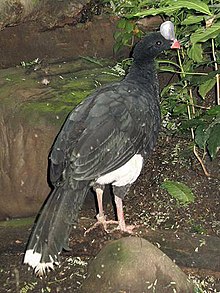
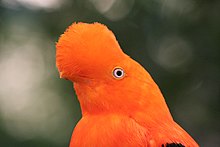



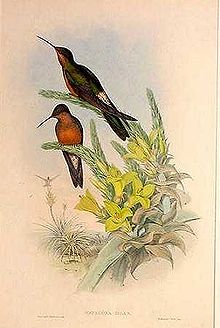
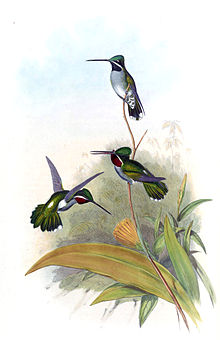
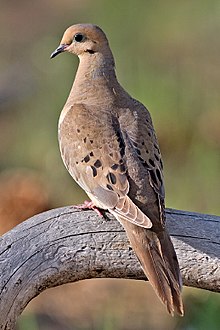
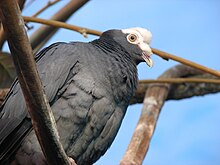





Over 1800 species of birds have been described in Colombia, (more than the number of existent bird species in North America and Europe combined).[2] Some of the bird species in Colombia are:
- American redstart
- Groove-billed ani
- Spotted antbird
- White-plumed antbird
- Antioquia bristle-tyrant
- Northern slaty-antshrike
- Blackish-grey antshrike
- Black-faced antthrush
- White-flanked antwren
- Checker-throated antwren
- Apical flycatcher
- Apolinar's wren
- Argus bare-eye
- Cinnamon attila
- Band-tailed barbthroat
- Pale-tailed barbthroat
- Baudó oropendola
- Beautiful woodpecker
- Bearded bellbird
- Black-and-gold tanager
- Black-chested buzzard-eagle
- Black-mandibled toucan
- Blackish tapaculo
- Bogotá rail
- Empress brilliant
- Fawn-breasted brilliant
- Brown-banded antpitta
- Buff-breasted mountain-tanager
- Red-rumped cacique
- Scarlet-rumped cacique
- Red-capped cardinal
- Gray catbird
- Little chachalaca
- Rufous-vented chachalaca
- Chestnut-bellied flower-piercer
- Chestnut-capped piha
- Chestnut-mandibled toucan
- Choco toucan
- Chocó vireo
- Clapper rail
- Andean cock-of-the-rock
- Guianan cock-of-the-rock
- Collared trogon
- Festive coquette
- Spangled coquette
- Buff-tailed coronet
- Velvet-purple coronet
- Pompadour cotinga
- Bronzed cowbird
- Crested ant-tanager
- Cundinamarca antpitta
- Great curassow
- Dickcissel
- Black-capped donacobius
- Common ground dove
- Grey-fronted dove
- Mourning dove
- White-tipped dove
- Dusky-headed brush-finch
- American harpy eagle
- Crested eagle
- Forest elaenia
- Yellow-crowned elaenia
- Andean emerald
- Blue-tailed emerald
- Glittering-throated emerald
- Versicoloured emerald
- Euler's flycatcher
- Orange-bellied euphonia
- Purple-crowned fairy
- Laughing falcon
- Flame-winged parakeet
- Acadian flycatcher
- Fuscous flycatcher
- Great crested flycatcher
- Ruddy-tailed flycatcher
- Sulphur-bellied flycatcher
- Orange-breasted fruiteater
- Black-faced hawk
- Common black hawk
- Bronzy hermit
- Great-billed hermit
- Green hermit
- Grey-chinned hermit
- Long-billed hermit
- Reddish hermit
- Rufous-breasted hermit
- Sooty-capped hermit
- Stripe-throated hermit
- Tawny-bellied hermit
- White-whiskered hermit
- Zigzag heron
- Purple honeycreeper
- Giant hummingbird
- Green-bellied hummingbird
- Indigo-capped hummingbird
- Ruby-topaz hummingbird
- Rufous-tailed hummingbird
- Snowy-breasted hummingbird
- Speckled hummingbird
- Steely-vented hummingbird
- Violet-bellied hummingbird
- Buff-necked ibis
- Brown inca
- Collared inca
- Bronzy jacamar
- Green-tailed jacamar
- Pale-headed jacamar
- Paradise jacamar
- Rufous-tailed jacamar
- Yellow-billed jacamar
- White-necked jacobin
- Green jay
- American pygmy kingfisher
- Great kiskadee
- Long-wattled umbrellabird
- Blue-backed manakin
- Lance-tailed manakin
- Wire-tailed manakin
- Green-breasted mango
- Tyrian metaltail
- Tropical mockingbird
- Amazonian motmot
- Andean motmot
- Whooping motmot
- Rufous motmot
- Mountain grackle
- Moustached brush-finch
- Multicoloured tanager
- Niceforo's wren
- Lesser nighthawk
- Northern helmeted curassow
- Brown nunlet
- Rusty-breasted nunlet
- Oilbird
- Baltimore oriole
- Orchard oriole
- South American yellow oriole
- Pale-legged warbler
- Parker's antbird
- Mealy amazon
- Yellow-eared parrot
- Green-rumped parrotlet
- Western wood pewee
- Black phoebe
- Band-tailed pigeon
- Ruddy pigeon
- Short-billed pigeon
- Collared puffbird
- Russet-throated puffbird
- White-necked puffbird
- Colorful puffleg
- Gorgeted puffleg
- Golden-headed quetzal
- White-tipped quetzal
- Booted racket-tail
- Red-bellied grackle
- Royal flycatcher
- Rufous-breasted wren
- Rufous-fronted parakeet
- Rufous-tailed antthrush
- Rusty-headed spinetail
- Santa Marta antpitta
- Santa Marta brush-finch
- Santa Marta bush-tyrant
- Santa Marta mountain-tanager
- Santa Marta parakeet
- Santa Marta tapaculo
- Santa Marta warbler
- Santa Marta wren
- Blue-chinned sapphire
- Scarlet macaw
- Black-necked screamer
- Horned screamer
- Variable seedeater
- Buff-tailed sicklebill
- White-tipped sicklebill
- Silvery-throated spinetail
- Red siskin
- Yellow-bellied siskin
- Sooty ant-tanager
- Sooty-capped puffbird
- Orange-billed sparrow
- Blue-tufted starthroat
- Long-billed starthroat
- Black storm-petrel
- Least storm-petrel
- Streak-capped spinetail
- Gorgeted sunangel
- Orange-throated sunangel
- Tree swallow
- Swallow-wing
- Short-tailed swift
- Sick's swift
- Violet-tailed sylph
- Blue-gray tanager
- Fulvous-crested tanager
- Olive tanager
- Paradise tanager
- Scarlet tanager
- Turquoise tanager
- White-shouldered tanager
- Green thorntail
- Wire-crested thorntail
- Spectacled thrush
- Wood thrush
- Barred tinamou
- Berlepsch's tinamou
- Black tinamou
- Brown tinamou
- Choco tinamou
- Cinereous tinamou
- Colombian tinamou
- Great tinamou
- Grey tinamou
- Grey-legged tinamou
- Highland tinamou
- Little tinamou
- Magdalena tinamou
- Red-legged tinamou
- Rusty tinamou
- Tawny-breasted tinamou
- Undulated tinamou
- Variegated tinamou
- White-throated tinamou
- Tolima dove
- Channel-billed toucan
- Keel-billed toucan
- White-throated toucan
- Emerald toucanet
- Groove-billed toucanet
- Slaty-tailed trogon
- Grey-winged trumpeter
- Buffy tuftedcheek
- Streaked tuftedcheek
- Turquoise dacnis
- Turquoise-throated puffleg
- Southern beardless tyrannulet
- Upper Magdalena tapaculo
- Velvet-fronted euphonia
- Violaceous trogon
- Brown violetear
- Lesser violetear
- Sparkling violetear
- Black-and-white warbler
- Black-throated green warbler
- Blackpoll warbler
- Palm warbler
- Prairie warbler
- Townsend's warbler
- Yellow warbler
- Waved albatross
- Cedar waxwing
- White-crowned pigeon
- White-lored warbler
- White-mantled barbet
- Purple-bibbed whitetip
- Amazonian barred-woodcreeper
- Black-banded woodcreeper
- Straight-billed woodcreeper
- Violet-crowned woodnymph
- Acorn woodpecker
- Ringed woodpecker
- Yellow-throated woodpecker
- Purple-throated woodstar
- Band-backed wren
- Stripe-backed wren
- Yariguies brush-finch
- Yellow-crowned redstart
- Yellow-headed brush-finch
- Yellow-rumped warbler
The national bird

The Andean condor inhabits the Andes mountain range. Although it is primarily a scavenger, feeding on carrion, this species belongs to the New World vulture family Cathartidae.
The condor is one of the largest birds on earth with a wingspan ranging from 274–310 cm (108–122 in) and weighing up to 11–15 kg (24–33 lb) for males and 7.5–11 kg (16–24 lb) for females, but overall length can range from 117 to 135 cm (46 to 53 inches).
The adult plumage is of a uniform black, with the exception of a frill of white feathers nearly surrounding the base of the neck and, especially in the male, large patches or bands of white on the wings which do not appear until the completion of the first molting.
Mammals
There are 456 reported species of mammals in Colombia.[3] Of these, about 22% are endangered or critically endangered. Most of the threatened species status are due to human activities, in particular destruction of plant and animal habitats driven by local consumption of organic resources, especially related to tropical forest destruction.[4]
While most of the species that are becoming extinct are not food species, their biomass is converted into human food when their habitat is transformed into pasture and cropland.
Colombia has the largest number of terrestrial mammals species in the world, including among others:
-
The spectacled bear another rare mammal specie, similar to the giant panda in Asia.


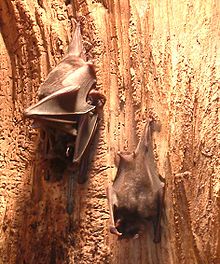
- Colombian woolly monkey
- Colombian black-handed titi
- Coppery titi
- Lucifer titi
- Black titi
- Collared titi
- Ornate titi
- White-fronted capuchin
- Olinguito
- Giant anteater
- Giant armadillo
- Greater long-nosed armadillo
- Hoffmann's two-toed sloth
- Linnaeus's two-toed sloth
- Myrmecophagidae
- Nine-banded armadillo
- Pale-throated three-toed sloth
- Pygmy marmoset
- Silky anteater
- Southern naked-tailed armadillo
- Southern tamandua
- Spectacled bear
- Tamandua
- Two-toed sloth
- Brown-throated three-toed sloth
- Amazonian manatee
- West Indian manatee
Amphibians
Colombia has the largest number of amphibians in the world (including frogs, toads, salamanders and caecilians) with 208 endangered species, being the zoological group with the highest rate of endangerment. Some causes related with the decline of the amphibians are: chytridiomycosis, habitat destruction, drought, air pollution, water pollution and illegal trade.
-
Phyllobates terribilis is the most venomous vertebrate worldwide
-
Hyalinobatrachium ruedai, glass frog
-
Hyalinobatrachium fleischmanni, Fleischmann's glass frog.
-
Eleutherodactylus marnockii, rain frog
-
Phyllobates aurotaenia, Kokoe dart frog
-
Harlequin poison frog, Dendrobates histrionicus
-
Giant leaf frog, Phyllomedusa bicolor
-
Black-legged dart frog, Phyllobates bicolor
-
Sapo toro, Leptodactylus pentadactylus
-
Sapo de celdas, Pipa pipa
Reptiles
-
Bothrops atrox is the main cause of death for snakebite in Colombia.
-
Pelamis platurus, pelagic sea snake
-
Cuvier's dwarf caiman, Paleosuchus palpebrosus
-
Orinoco crocodile, Crocodylus intermedius
-
Spectacled caiman, Caiman crocodilus
-
Black caiman, Melanosuchus niger
-
Mata mata, Chelus fimbriatus
-
Red-footed tortoise, Geochelone carbonaria
-
Common snapping turtle, Chelydra serpentina
-
Tupinambis teguixin, gold tegu or Colombian tegu
Fish
-
Ram cichlid, Mikrogeophagus ramirezi
-
Pirarucu, (Arapaima gigas) is the largest fresh-water fish in the world.
-
Leporinus obtusidens
-
Hemichromis letourneauxi
Molluscs
There are more than 80 genera of land gastropods in (continental) Colombia.[5]
Insects
-
Catalina orangetip
-
Atta laevigata, edible Hormiga Culona Santandereana (see also Colombian cuisine)
See also
- List of invasive species in Colombia
- Animal rights in Colombia
- Flora of Colombia
- List of national parks of Colombia
References
- ^ en Colombia Paisajes naturales de Colombia
- ^ a b "Colombia accounts for around 10% of the flora and fauna of the world". humboldt.org.co. Retrieved 21 July 2013.
- ^ http://www.humboldt.org.co/biota/vol1no1/03.%20Mamiferos_de_Colombia.pdf
- ^ Paul Ehrlich and Anne Ehrlich, Extinction, Random House, New York (1981) ISBN 0-394-51312-6
- ^ Mónica Lucía Vera Ardila. 2008. Lista de los géneros de moluscos terrestres de Colombia (Mollusca: Gastropoda: Prosobranchia: Mesogastropoda y Pulmonata: Stylommatophora). Biota Colombiana 9 (1): 39-62.















































